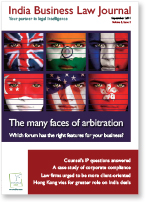India’s growing network of toll roads is symbolic, both of the country’s promise and its problems
The flurry of activity that surrounds bids for concessions for highway projects, and the sky high premiums paid for them, point to an India with perfectly maintained highways that connect seamlessly. But as three in 10 projects result in arbitration between the road building contractor and the implementing authority of the government’s road building programme, the National Highways Authority of India, that may be some way away.
Most of these disputes are decided by arbitral tribunals. However, their decisions do not count for much in a country that, according to Fali Nariman, a senior counsel and authority on arbitration, has “developed into a fine art how not to honour an arbitral award – foreign or domestic”. So it comes as no surprise that the National Highways Authority – which is involved in disputes totalling more than ₹110 billion (US$2.2 billion) – is setting up a 14-member committee to decide if arbitral awards made against it should be challenged in court.
This will do little to inspire confidence in arbitration as it is practised in India. The finality of an arbitral award should be especially sacred in a country where overcrowded courts cannot provide swift resolution of disputes. The rapid growth of the economy demands an efficacious alternative.

With international arbitral institutions muscling in on the action, competition is intense. In an attempt to be transparent and win business, several of them are going to extraordinary lengths to provide information that explains their costs, processes and value proposition. But as we reveal, fees for arbitrators and arbitral institutions might account for only a fifth of the total cost in any arbitration.
The lion’s share is the cost of presenting the case and that includes fees and expenses paid to legal advisers. This could mean that institutional arbitration, which is considered more efficient, is more viable than generally held, even when the stakes are small. But a change of mindset may be needed before parties are persuaded of the benefits of this kind of arbitration.
A change of mindset is also recommended in the marketing of legal services. Writing in this month’s Vantage point (Changing a mindset, page 16) Robert Sawhney, a marketing expert who works with professional services firms, argues that marketing is not just about creating a new brochure or a fancy logo. It runs through everything a law firm does and is the key driver for creating and delivering client value.
Sawhney makes the case that technical knowledge is not enough as clients demand commercially oriented advice delivered by lawyers who understand their business. In a thought provoking article, which goes to the heart of how law firms go about their business, Sawhney suggests that lawyers and law firms are far behind the game in marketing themselves. According to him this is because they are protected. But can this last? Sawhney’s opinions may provide a much needed wake-up call.
In this issue’s What’s the deal? (Back on track?, page 33), we focus on the aftermath of another wake-up call, caused by the sniff of corruption and hefty penalties that followed. Here Lord Goldsmith QC, a former attorney general of the UK and a partner at Debevoise & Plimpton, describes how Siemens, a German engineering conglomerate, put in place a comprehensive compliance programme after confronting allegations of bribery in 2007 and 2008.
A key finding of Siemens’ assessment of malpractices and of deficiencies in the compliance system was that evidence of misconduct was not investigated soon enough or with sufficient resolve. This indicated a deep rooted problem. But the company not only successfully cleaned up its act, it also picked up substantial new work in the years that followed. How this was achieved will be instructive for other companies that are rapidly expanding and need to prevent, detect and respond to wrongdoings effectively.
We are well aware of corporate counsel’s constant need for well thought out advice that they can trust. With that in mind we sought their most pressing questions about intellectual property and invited responses from a panel of IP experts. The result, presented in this issue’s Intelligence report (IP demystified, page 37), is a compilation of questions and answers that can assist every in-house lawyer.
Hong Kong has long been a springboard for entry into China for international law firms. For some the city is also a strategic location for India-related work. In this month’s Spotlight (A city that never sleeps, page 27) we look at law firms that manage their India-related work from Hong Kong. We talk to the movers and shakers to get to grips with what it means to be locked out of the Indian market but yet heavily involved in it. This provides valuable clues as to how to win India-related deals and execute them from afar without hitting too many potholes along the way.



























